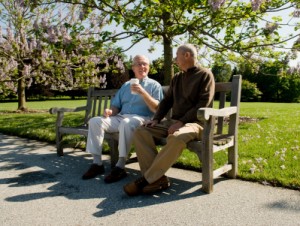 EXAMPLES: Person-Centered Planning and Community Living
EXAMPLES: Person-Centered Planning and Community Living
Katie’s Story
Listen to Katie as she describes how person-centered planning has impacted her life.
Cliff’s Story
For 20 years, Cliff lived in a nice “downtown” apartment in a very rural Minnesota town. Downtown consisted of a few blocks with one stoplight. He worked as a busser and dishwasher at a nearby restaurant and was known by the patrons for his upbeat nature and for always whistling while he cleared tables. He was especially well known by the guys who gathered every morning at the local coffee shop near his apartment downtown; they talked about cars and the news and sometimes how lucky Cliff was to be single.
Cliff owned his own car and lived by himself in his apartment for most of his adult life. He was always  very proud of his independence. He worked hard and he played hard on the weekends. Cliff is an avid camper and fisherman. He owned almost everything you would need to camp in 3 full seasons in Minnesota. He also had a huge amount of fishing gear. Cliff enjoyed people at the coffee shop and at work, but his evenings and weekends were often about time alone in nature.
very proud of his independence. He worked hard and he played hard on the weekends. Cliff is an avid camper and fisherman. He owned almost everything you would need to camp in 3 full seasons in Minnesota. He also had a huge amount of fishing gear. Cliff enjoyed people at the coffee shop and at work, but his evenings and weekends were often about time alone in nature.
Cliff received some support in his apartment due to a diagnosis of intellectual disability. Primarily, his weekly staff helped him to manage his finances, pay bills and keep on track with routine medical appointments. He liked his staff and enjoyed his independence immensely.
Cliff was generally very healthy until he had a stroke in his mid-forties. He was admitted to a nearby hospital and later spent many months in rehab. Cliff worked hard to rebuild his skills, with his sights set firmly on getting his life and independence back. While his case manager followed him, no one thought to tell his landlord or his friends at the coffee shop. The landlord eventually sold all of Cliff’s belongings, including his extensive and loved camping and fishing gear. When Cliff was ready to move, his case manager arranged for him to go from rehab into an ICF-DD facility in a nearby town.
After Cliff moved into his new home, which was near his old community but in a much larger town, he started rebelling. He frequently yelled at staff, stormed off when they were talking with him and was generally a cranky guy, not the whistling and happy guy he once was before the stroke. He was now being talked about as a behavior problem.
When staff would remind Cliff that was still “re-learning,” that only made matters worse. Cliff yelled louder, called them names and spent a lot of time in his room.
They called in a behavior specialist to help them manage Cliff’s increasing “verbal aggression.” What that person determined was that a Person Centered Plan was where to start with Cliff, to better understand what really matters to him. They held two planning sessions, which focused on learning what was important TO Cliff and what had worked really well for him earlier in his life.
But what they learned the most about – and what was easiest for Cliff to talk about – was what wasn’t working for him. In fact it became a list of what was TOXIC to him about where he was living currently.
The “Good Day/Bad Day” tool (one of the Person-Centered Thinking tools) was very enlightening to his team; it was easy to see that almost everything about his current placement was creating more Bad Days for Cliff. He mentioned hating living with other people, especially people with developmental disabilities. He talked about missing living in a rural community, missing his quiet evenings at home, being too far from the water and nature. It was clear he was miserable.
After the full plan was shared, his case manager finally agreed to begin looking for a new home for Cliff. He was cautioned it would take time as there weren’t many places available. Cliff toured many homes with his planner, who he had come to trust. He kept saying “well, this is a lot better than where I’m at now!” but his planner encouraged Cliff not to settle. They focused on finding a match for what worked for him – for the things that made for a Good Day – not just easing the pain of where he was.
Eventually they toured a farmhouse that had been converted to a supported living facility. It had the right staffing support for his needs but gave him the independence he craved. Staff lived on the main level of the farmhouse; the open apartment was a one bedroom, completely separate apartment on the mid-level; two neighbors lived in the 2-bedroom apartment on the top level. As they toured this place Cliff seemed relieved. But the caretaker, who had read Cliff’s plan, had one other thing to show him. They walked out onto the farm, past the old barn and garage, to show Cliff the stream running through the property, and the small camp shack/cabin on the edge of the property where he could fish and “get away” every weekend.
After Cliff moved here, he never had another “behavior.”
